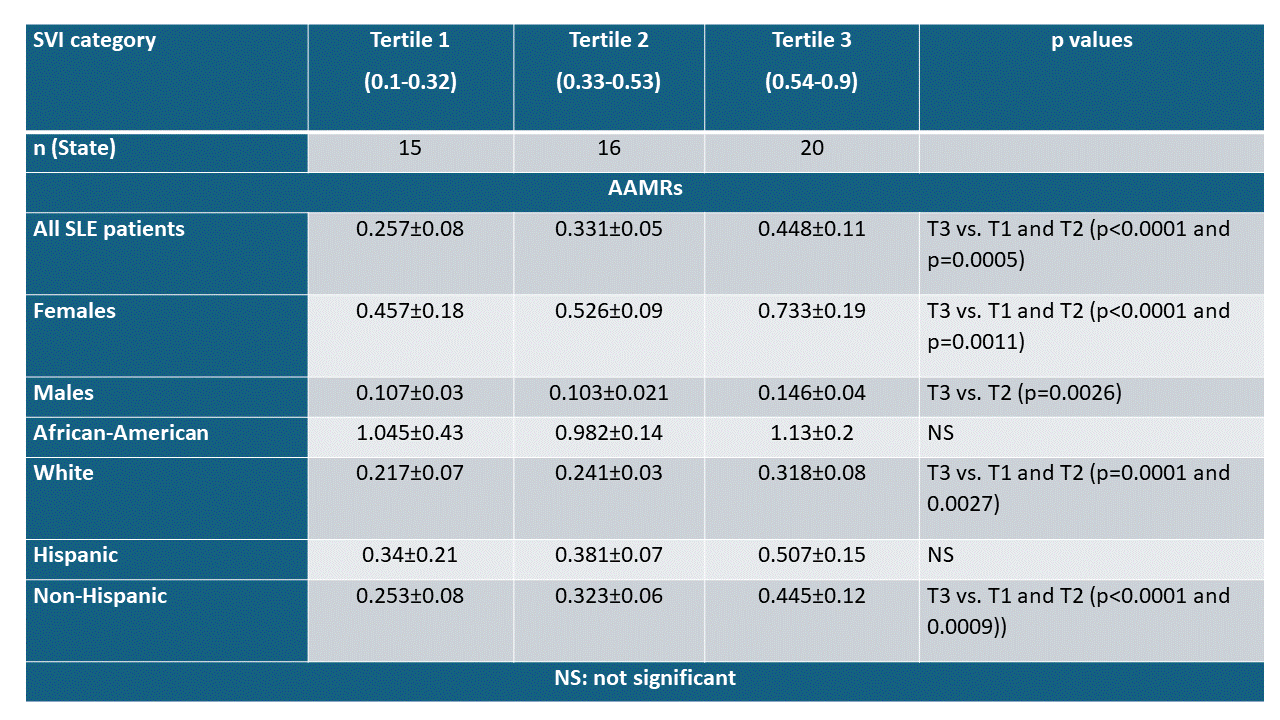Session Information
Session Type: Poster Session B
Session Time: 10:30AM-12:30PM
Background/Purpose: Epidemiological studies have shown significant health disparities in systemic lupus erythematosus (SLE). The Centers for Disease Control and Prevention (CDC) developed the social vulnerability index (SVI) to identify communities that may be at high risk for specific diseases or events. In this study, we aimed to investigate the relationship between state- and county-level SVI and changes in SLE-related age-adjusted mortality rates (AAMRs) over a 20-year period in the U.S.
Methods: SLE-related AAMR data were obtained from the CDC WONDER. Data were extracted from 1999 through 2020 in two 11-year periods: 1999-2009 and 2010-2020. Additionally, data from both periods were pooled to obtain the SLE-related AAMR over the entire study period. The CDC WONDER algorithm defines cause-specific mortality rates as unreliable with raw counts below 20 for any location.
SVI data for 2009 and 2020 were obtained from the CDC Agency for Toxic Substances and Disease Registry, which ranks every U.S. census tract on social factors using the American Community Survey data. The SVI ranks census tracts on 15 social factors, and further groups them into four related themes: socioeconomic status (SES), housing and transportation (HT), minority status (MS), and household composition (HC). State-level SVI categories were created by computing CDC county-level SVI estimates as weighted aggregates. All states were classified into three categories based on their weighted SVI scores: Tertile 1 (0.10-0.32), Tertile 2 (0.33-0.53), and Tertile 3 (0.54-0.90). Higher SVI scores and tertiles correspond to a higher burden of factors that result in social vulnerability.
Results: Compared to the first and second tertiles of SVI, U.S. states in the third tertile exhibited higher SLE-related average AAMR. Within third tertile states, SLE-related average AAMRs were also notably higher in females, White, and non-Hispanic populations compared to first and second tertiles due to their SVI scores. Among males, SLE-related AAMR was higher in the third tertile states compared to the second tertile (Table 1). There were no significant differences in SLE AAMRs among black and Hispanic populations across states.
For US counties, AAMR data for SLE was available in only 265 counties from 50 states. We evaluated the relationship between SLE-related AAMR and SVI scores. Our analysis showed that SLE-related AAMRs significantly correlated with SVI scores in these counties (r=0.61, R2=0.38, p< 0.0001). In addition, we analyzed the relationship between SLE-related AAMRs and various SVI sub-categories. SLE-related AAMR correlated with scores of SES (r=0.65, R2=0.42), HC (r=0.44, R2=0.19), MS (r=0.39, R2=0.15) and HT (r=0.4, R2=0.16) (p values < 0.001).
To analyze changes during the study period, we estimated AAMRs for SLE in two periods (1999-2009 and 2010-2020). We detected a weak inverse correlation between the decline of AAMR and SVI scores (r=-0.21, R2=0.043, p=0.025).
Conclusion: Our study showed that SVI is a good predictive parameter for SLE mortality, especially for female and White SLE patients. In recent two decades, SLE-related mortality declined more prominently in regions with low levels of social vulnerability.
To cite this abstract in AMA style:
Pamuk O, Daoud A, Cetin H, Magrey M. State-and-County-Level Social Vulnerability Index and Trends in Systemic Lupus Erythematosus-Related Mortality in the U.S [abstract]. Arthritis Rheumatol. 2024; 76 (suppl 9). https://acrabstracts.org/abstract/state-and-county-level-social-vulnerability-index-and-trends-in-systemic-lupus-erythematosus-related-mortality-in-the-u-s/. Accessed .« Back to ACR Convergence 2024
ACR Meeting Abstracts - https://acrabstracts.org/abstract/state-and-county-level-social-vulnerability-index-and-trends-in-systemic-lupus-erythematosus-related-mortality-in-the-u-s/

